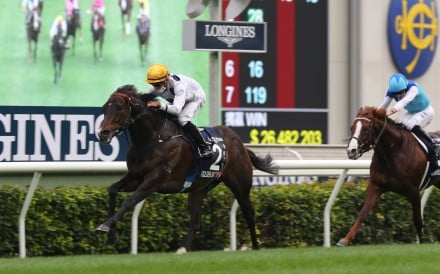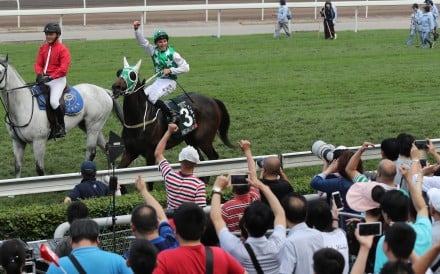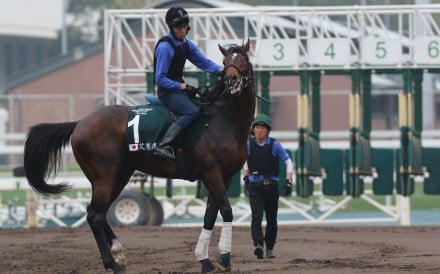Sunday’s preludes at Sha Tin were all about running rails – at least one rail, anyway, in the wash-up of a day on which things seemed to become simultaneously clearer and more confusing, whether it’s good to be drawn near the fence or not.
Even in the build-up to the three international trials some of the talk was about the rail – the question of whether tearaway Amber Sky could run anywhere near it rounding Sha Tin’s right hand bend and how most connections wanted to be drawn next to it in their respective races, particularly in the Jockey Club Sprint.
In the end, barriers one and two proved to be poison over a trip where they are meant to be vital – 1,200m. It’s not often the term “he was an unlucky last of 14” can be uttered with a straight face, but that was the fate of Aerovelocity from gate one, while Lucky Nine was at his unlucky best as he got held up in a traffic jam of Occupy protest proportions after jumping from barrier two.
Back to Amber Sky, who had failed around a bend twice previously, and before the race new jockey (read: experimental supersonic spacecraft test pilot), Mirco Demuro, had claimed the sprinter “doesn’t like the rail” and planned to make like compatriot Valentino Rossi and take a wide line into the first turn from barrier nine.
The claim Amber Sky suffers from Runningrailitis – a fear of and/or severe allergy to running rails – seemed unfounded post-race after Amber Sky was continually drawn to the fence in the home straight, repeatedly slamming Aerovelocity as Zac Purton looked for runs on his inside.
The most famous sufferer of Runningrailitis in Hong Kong is of course, the quintessential “mercurial French jockey” (is there any other type?) Gerald Mosse.
Monsieur Mosse’s apparent allergy to paint was proved to be well-founded when in Sunday’s Jockey Club Mile he was stuck for room on Ambitious Dragon and couldn’t get away from the inside. Tony Millard was left to make history as the first trainer to ever complain post-race about Mosse being too close to the fence during a race.
It wouldn’t have mattered where Ambitious Dragon was anyway, for he was facing an equine-alien hybrid life form known as Able Friend anyway, but what about those unfortunate sprint runners?
Peniaphobia is a fear of poverty, and also a completely unfounded one for the owners of the horse of the same name. Unfortunately he may develop a dual diagnosis, adding to his healthy fear of poverty with some Runningrailitis after Sunday – after overcoming what on analysis looks a “too good to be true” run.
He drew a dud gate – the “worst” – barrier 14, and raced widest of all the horses, sitting “four deep, no cover” for jockey Douglas Whyte.

Racing people raised in Australia have had the mantra “get to the fence” drilled into their heads since birth. Simple really: “It’s the shortest way around.” Position first, worry about clear running when you need to and do what you have to do.
This ideology clashes with the European and, to a certain extent, Japanese, view – jurisdictions where jockeys like clear space and room to move, and for the horse to find rhythm and breathe. As for Americans? They just seem to go as fast as they can and then see who makes it to the finish first.
Irish jockey Neil Callan, who continued to gain a foothold among the top echelon with another big race win in the Jockey Club Cup on Sunday, says it’s all about adapting to where you are riding.
The jockey dubbed “ironman” by the local press says that if the obsession with being “three back the paint” was applied to riding in Europe, where team tactics are allowed and races slowly build into the final stages from sometimes sedentary tempos, a jockey would face an Aerovelocity-like situation in every other race.
Mosse steadfastly defends his style, even when riding here and in Australia – and it’s hard to argue with his overall career resume.
Another masterful Melbourne Cup ride last month by Mosse showed how being in clear space can allow a rider to be more instinctive and flow into a contest, particularly in the slower-moving staying races.
In the middle stages he improved his position on Red Cadeaux “for nothing” as the pace slackened and his rivals stayed stuck in their pre-determined positions dictated by inflexible “paint by numbers” strategies.
After winning the Caulfield Cup last month, even Zac Purton – as efficient a ground saving jockey as there is – justified going “around the horn” on Admire Rakti, saying it is how Japanese horses like to be ridden.
Another Japanese freak, Lord Kanaloa, won back-to-back Hong Kong Sprints and in last year’s five length demolition, jockey Yasunari Iwata showed complete disdain for the laws of physics by sitting wide on a “horse” – admittedly another of those equine-alien hybrids.
In the 2011 Hong Kong Sprint, winner Lucky Nine sat deep, albeit with an all-important trail – and as one follower to @SCMPRacingPost pointed out after the other worldly performance of Peniaphobia, a wide trailing position doesn’t seem to be the worst place to be in a hard run 1,200m at Sha Tin.
If Sunday’s sprint race shows us anything it’s that statistics and the best laid plans can amount to nothing.
The messy contest was a reminder that each race is it’s own living and breathing individual creature that can’t be predicted with maths, science or a measuring tape.
Even if you could foresee the future, if Purton and Lucky Nine’s rider Prebble had been able to pick where they would be approaching the turn, they probably wouldn’t change a thing. Nine times out of 10 the field breaks up, horses fan wide off the turn and runs appear.
Just as well connections don’t have to pick their own draws before the Hong Kong Sprint, as is the process before some big races, because it would leave many scratching their heads as to what to do – the same thing the race selection committee are doing now as it decides who to pick for the event.





















